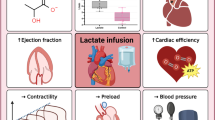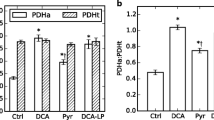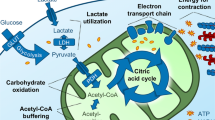Abstract
The goal of this study was to investigate the effect of 1 mM exogenous lactate on cardiac function, and some metabolic parameters, such as glycolysis, glucose oxidation, lactate oxidation, and fatty acid oxidation, in isolated working rat hearts. Hearts from male Sprague-Dawley rats were isolated and perfused with 5 mM glucose, 1.2 mM palmitate, and 100 μU/ml insulin with or without 1 mM lactate. The rates of glycolysis, glucose, lactate, and fatty acid oxidation were determined by supplementing the buffer with radiolabeled substrates. Cardiac function was similar between lactate+ and lactate− hearts. Glycolysis was not affected by 1 mM lactate. The addition of lactate did not alter glucose oxidation rates. Interestingly, palmitate oxidation rates almost doubled when 1 mM lactate was present in the perfusate. This study suggests that subst rate supply to the heart is crucially important when evaluating the data from metabolic studies.
Similar content being viewed by others
References
Lopaschuk GD: Advantages and limitations of experimental techniques used to measure cardiac energy metabolism. J Nucl Cardiol 4:316–328, 1997
Barr RL, Lopaschuk GD: Methodology for measuring in vitro/ex vivo cardiac energy metabolism. J Pharmacol Toxicol Methods 43(2):141–152, 2000
Rosier CD, Llyod S, Comte B, Chatham JC: A critical perspective of the use of 13C-isotopomer analysis by GCMS and NMR as applied to cardiac metabolism. Metab Eng 6: 44–58, 2004
Chatham JC, Bouchard B, Des Rosiers C: A comparison between NMR and GCMS 13C-isotopomer analysis in cardiac metabolism. Mol Cell Biochem 249:105–112, 2003
Stanley WC, Recchia FA, Lopaschuk GD: Myocardial substrate metabolism in the normal and failing heart. Physiol Rev 85:1093–1129, 2005
Jeffrey FMH, Diczku V, Sherry AD, Malloy CR: Substrate selection in the isolated working heart: effects of reperfusion, afterload and concentration. Basic Res Cardiol 90: 388–396, 1995
Chatham JC, Forder JR: Relationship between cardiac function and substrate oxidation in hearts of diabetic rats. Am J Physiol 273:H52–H58, 1997
Chatham JC, Gao ZP, Bonen A, Forder JR: Preferential inhibition of lactate oxidation relative to glucose oxidation in the rat heart following diabetes. Cardiovasc Res 43:96–106, 1999
Chatham JC, Gao ZP, Forder JR: Impact of 1 wk of diabetes on the regulation of myocardial carbohydrate and fatty acid oxidation. Am J Physiol 277:E342–E351, 1999
Chatham JC, Seymour AM: Cardiac carbohydrate metabolism in Zucker diabetic fatty rats. Cardiovasc Res 55:104–112, 2002
Lloyd SG, Wang P, Zeng H, Chatham JC: Impact of low-flow ischemia on substrate oxidation and glycolysis in the isolated perfused rat heart. Am J Physiol 287:H351–H362, 2004
Wang P, Lloyd SG, Zeng H, Bonen A, Chatham JC: Impact of altered substrate utilization on cardiac function in isolated hearts from Zucker diabetic fatty rats. Am J Physiol 288:H2102–H110, 2005
Wang P, Lloyd SG, Chatham JC: Impact of high glucose/high insulin and dichloroacetate treatment on carbohydrate oxidation and functional recovery after low-flow ischemia and reperfusion in the isolated perfused rat heart. Circulation 111:2066–2072, 2005
Lopaschuk GD, Collins-Nakai RL, Itoi T: Developmental changes in energy substrate use by the heart. Cardiovasc Res 26:1172–1180, 1992
Onay-Besikci A: Regulation of cardiac energy metabolism in newborn. Mol Cell Biochem, in press
Medina JM: The role of lactate as an energy substrate for the brain during the early neonatal period. Biol Neonate 48:237–244, 1985
Mazer CD, Stanley WC, Hickey RF, Neese RA, Cason BA, Demas KA, Wisneski JA, Gertz EW: Myocardial metabolism during hypoxia: maintained lactate oxidation during increased glycolysis. Metabolism 39:913–918, 1990
Connolly CC, Stevenson RW, Neal DW, Wasserman DH, Cherrington AD: The effects of lactate loading on alanine and glucose metabolism in the conscious dog. Metabolism 42:154–161, 1993
Large V, Soloviev M, Brunengraber H, Beylot M: Lactate and pyruvate isotopic enrichments in plasma and tissues of postabsorptive and starved rats. Am J Physiol 268:E880–E888, 1995
Lopaschuk GD, Spafford MA, Marsh DR: Glycolysis is predominant source of myocardial ATP production immediately after birth. Am J Physiol 261:H1698–H1705, 1991
Werner JC, Sicard RE: Lactate metabolism of isolated, perfused fetal, and newborn pig hearts. Pediatr Res 22:552–556, 1987
Bartelds B, Knoester H, Smid GB, Takens J, Visser GH, Penninga L, van der Leij FR, Beaufort-Krol GC, Zijlstra WG, Heymans HS, Kuipers JR: Perinatal changes in myocardial metabolism in lambs. Circulation 102: 926–931, 2000
Bartelds B, Knoester H, Beaufort-Krol GC, Smid GB, Takens J, Zijlstra WG, Heymans HS, Kuipers JR: Myocardial lactate metabolism in fetal and newborn lambs. Circulation 99:1892–1897, 1999
Bartelds B, Gratama JW, Knoester H, Takens J, Smid GB, Aarnoudse JG, Heymans HS, Kuipers JR: Perinatal changes in myocardial supply and flux of fatty acids, carbohydrates, and ketone bodies in lambs.Am J Physiol 274:H1962–H1969, 1998
Lloyd S, Brocks C, Chatham JC: Differential modulation of glucose, lactate, and pyruvate oxidation by insulin and dichloroacetate in the rat heart. Am J Physiol 285:H163–172, 2003
Schönekess BO. Competition between lactate and fatty acids as sources of ATP in the isolated working rat heart. J Mol Cell Cardiol 29:2725–2733, 1997
Ferdinandy P, Panas D, Schulz R. Peroxynitrite contributes to spontaneous loss of cardiac efficiency in isolated working rat hearts. Am J Physiol 276:H1861–H1867, 1999
Lopaschuk GD, Collins-Nakai R, Olley PM, Montague TJ, McNeil G, Gayle M, Penkoske P, Finegan BA. Plasma fatty acid levels in infants and adults after myocardial ischemia. Am Heart J 128:61–67, 1994
Atkinson LL, Fischer MA, Lopaschuk GD: Leptin activates cardiac fatty acid oxidation independent of changes in the AMP-activated protein kinase-acetyl-CoA carboxylase-malonyl-CoA axis. J Biol Chem 277:29424–29430, 2002
Longnus SL, Wambolt RB, Barr RL, Lopaschuk GD, Allard MF: Regulation of myocardial fatty acid oxidation by substrate supply. Am J Physiol 281:H1561–H1567, 2001
Taniguchi M, Wilson C, Hunter CA, Pehowich DJ, Clanachan AS, Lopaschuk GD: Dichloroacetate improves cardiac efficiency after ischemia independent of changes in mitochondrial proton leak. Am J Physiol 280:H1762–H1769, 2001
McCormack JG, Barr RL, Wolff AA, Lopaschuk GD: Ranolazine stimulates glucose oxidation in normoxic, ischemic, and reperfused ischemic rat hearts. Circulation 93:135–142, 1996
Kudo N, Barr AJ, Barr RL, Desai S, Lopaschuk GD: High rates of fatty acid oxidation during reperfusion of ischemic hearts are associated with a decrease in malonyl-CoA levels due to an increase in 5’-AMP-activated protein kinase inhibition of acetyl-CoA carboxylase. J Biol Chem 270:17513–17520, 1995
Saddik M, Gamble J, Witters LA, Lopaschuk GD: Acetyl-CoA carboxylase regulation of fatty acid oxidation in the heart. J Biol Chem 268:25836–25845, 1993
Broderick TL, Quinney HA, Lopaschuk GD: Carnitine stimulation of glucose oxidation in the fatty acid perfused isolated working rat heart. J Biol Chem 267:3758–3763, 1992
Lopaschuk GD, Spafford MA, Davies NJ, Wall SR: Glucose and palmitate oxidation in isolated working rat hearts reperfused after a period of transient global ischemia. Circ Res 66:546–553, 1990
Wambolt RB, Lopaschuk GD, Brownsey RW, Allard MF: Dichloroacetate improves postischemic function of hypertrophied rat hearts. J Am Coll Cardiol 36:1378–1385, 2000
Halestrap AP, Price NT: The proton-linked monocarboxylate transporter (MCT) family: structure, function and regulation. Biochem J 343:281–299, 1999
McClelland GB, Khanna S, Gonzalez GF, Butz CE, Brooks GA: Peroxisomal membrane monocarboxylate transporters: evidence for a redox shuttle system? Biochem Biophys Res Commun 304:130–135, 2003
Acknowledgment
The author would like to thank Dr. Gary D. Lopaschuk at University of Alberta for providing the laboratory facilities and his helpful suggestions.
Author information
Authors and Affiliations
Corresponding author
Rights and permissions
About this article
Cite this article
Onay-Besikci, A. Impact of lactate in the perfusate on function and metabolic parameters of isolated working rat heart. Mol Cell Biochem 296, 121–127 (2007). https://doi.org/10.1007/s11010-006-9305-5
Received:
Accepted:
Published:
Issue Date:
DOI: https://doi.org/10.1007/s11010-006-9305-5




